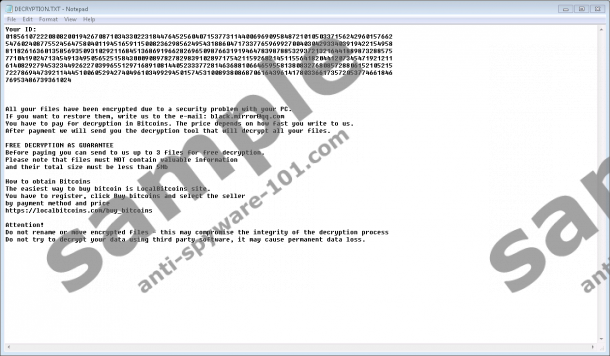What is Oled Ransomware?
Oled Ransomware is a highly dangerous file-encrypting threat as it can continuously lock new data added on the computer as long as it remains on the user’s system. Thus, in order not to receive any more damage the user should remove this malicious application at once. The malware’s creators might advise you not to erase the malware and purchase a decryption tool from them, but we do not think it would be wise to trust these people since there are no reassurances such a tool will be provided. They could sound friendly and reassuring, but once these hackers get your money you may no longer hear from them, or they could ask you to pay even more. However, if you have no intention to risk your savings, we encourage you to use the removal instructions placed below and read the article too to learn more significant details about Oled Ransomware.
Where does Oled Ransomware come from?
According to victims’ reports, the malicious application enters the system through infected email attachments. Such distribution method remains to be popular for quite some time now, so our specialists at Anti-spyware-101.com often urge users to be more careful with suspicious email attachments. Before opening the file, it would be smart to firstly check who sent it and try to figure out why the file was addressed to you. If you did not expect to receive it or find it suspicious, it is most advisable to employ a reliable antimalware tool. The attachment in question should be scanned with it to verify whether it is safe to launch it. It might take you a couple of minutes to investigate the file but keep it in mind that doing this might save your data from ruin.
How does Oled Ransomware work?
After launching the infected file, Oled Ransomware is supposed to create a copy of itself in the %APPDATA% directory. The copy’s title could be completely random, so to recognize it users should search for an unseen executable file that was placed by the time the device got infected. Moreover, the malicious application should also create a Registry entry in the HKCU\Software\Microsoft\Windows\CurrentVersion\RunOnce path. In this case, the value name’s tile might be a CLSID, for example, {B7E8B556-B1AA-B9EB-GG3D-GG3D59D10747}, while its value data should point to the path where the malware placed its copy. This particular Registry entry is added so that the infection could launch itself over and over again every time the PC is turned on.
In the next stage, Oled Ransomware may encrypt all personal files located in the %USERPROFILE% and %HOMEDRIVE% directories. This means program data placed in the %WINDIR% or %PROGRAMFILES% folders should remain unaffected, but you can separate encrypted files yourself from the additional .[black.mirror@qq.com].oled extension, which should be added at the end of each locked file. Then the malware is supposed to create ransom notes titled as DECRYPTION.TXT in all directories containing encrypted data. To be able to open this note automatically when the system restarts the malicious application should create another similar Registry entry; this time in the HKCU\Software\Microsoft\Windows\CurrentVersion\Run path.
The ransom note instructs the user to contact the malware’s creators through given email address and says how to pay the ransom. As we stated before, we do not advise paying the ransom since these hackers could trick you. Do not forget that as long as the threat stays on your computer, it will monitor it and encrypt any newly created files, so it is best you delete Oled Ransomware fast before it has the chance to do more damage.
How to eliminate Oled Ransomware?
To get rid of Oled Ransomware manually you would have to locate and delete all its files separately. If you feel up to such a task, we encourage you to follow the instructions placed below and erase this malicious application at once. Naturally, this task might appear to be too difficult if you do not have a lot of experience with malware, but there is nothing to worry about since in such case you can acquire a legitimate antimalware tool and leave the ransomware’s removal to it. Also, if you need any further assistance, you could try to reach us via social media or leave a comment below.
Erase Oled Ransomware
- Press Ctrl+Alt+Delete.
- Select Task Manager.
- Search for a malicious process belonging to the ransomware.
- Select this process and press the End Task button.
- Close the Task Manager and press Win+E.
- Find the malicious email attachment you had launched before the system got infected.
- Right-click this file and select Delete.
- Go to %APPDATA%
- Locate the malware’s copy; an executable file with a random title.
- Right-click it and choose Delete.
- Remove all ransom notes (DECRYPTION.TXT).
- Close the Explorer.
- Press Win+R, insert Regedit and tap OK.
- Go to these directories separately:
HKCU\Software\Microsoft\Windows\CurrentVersion\Run
HKCU\Software\Microsoft\Windows\CurrentVersion\RunOnce - Locate value names belonging to the infection (e.g. {B7E8B556-B1AA-B9EB-GG3D-GG3D59D10747}; their value data should point to the malware’s copy and to the location of one of the ransom notes.
- Right-click these value names and press Delete.
- Exit the Registry Editor.
- Empty Recycle bin.
100% FREE spyware scan and
tested removal of Oled Ransomware*





0 Comments.